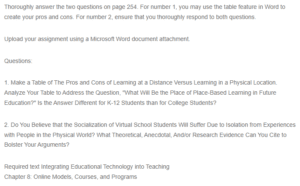Distance and Physical Learning
Distance or online learning and physical or face-to-face learning are different types. Distance learning is learning where instruction between the tutor and students is disconnected by physical distance, and various technological Media achieve communication. Physical learning is a standard type where students and teachers meet simultaneously at the exact location and in a conducive environment for a series of sessions (Roblyer and Doering 243). Therefore, what are the pros and cons of these two types of learning?
Hire our assignment writing services if your assignment is devastating you.
| Distance learning | Physical learning | |
| Pros | · It is the most flexible type of learning, irrespective of employment, age, and status.
· The course completion rate is individually decided as one can review the module repeatedly until one understands. · You can learn anywhere you feel comfortable, whether in the kitchen, outside, or house. · One can learn and also earn. · It’s cheap or pocket-friendly (Sadeghi 83).
|
· It is the most appropriate and essential for effective learning.
· A learner gets instant interaction and answers in real-time. · People can prepare and share notes and create a socializing network with other learners. · It is motivating as opposed to online learning (Sadeghi 85). |
| Cons | · Questioning quality is debatable
· Inadequate student accountability · Students can get overwhelmed by learning materials. · There is an absence of individual feedback and attention · Missing out on campus, social life, or socialization (Sadeghi 83). |
· Its tuition fee is costly.
· One is forced to travel. · One must pay for textbooks · One must incur managerial and organizing costs. (Sadeghi 85) |
The rising national and broad interest in project-based learning pooled with the awareness that situating these projects in learners’ homes can enhance their effect and meaning, indicating that interest in place-based education will continue developing in the coming years (Lee 1259). It might be different for K–12 Students than for College Students because people have divergent points of view. However, it will also have a chance to remain the same because of the thought of future education that is technologically based.
Indisputably, the socialization of virtual school students will suffer because of isolation from experiences with people within the physical world. Lee (2018) affirms that institutions are drastically shifting towards distance learning approaches. It has real risks because the online learning approaches can be didactic and solitary when instructors expect or ask learners to sit and silently read documents and click presentations and videos that are boring and less interactive (p. 1258). Since this form of learning is passive, as it requires sitting and listening, it serves nobody well, especially people from the furthest behind it, causing social isolation, which contributes to student frustration and depression due to a lack of interaction and experiences from the physical world.
Works Cited
Lee, Kyungmee. “Everyone already has their community beyond the screen: reconceptualizing online learning and expanding boundaries.” Educational Technology Research and Development 66.5 (2018): 1255-1268.
Roblyer, Margaret, and Aaron H. Doering. Integrating educational technology into teaching. USA: Pearson, 2015.
Sadeghi, Manijeh. “A shift from classroom to distance learning: Advantages and limitations.” International Journal of Research in English Education 4.1 (2019): 80-88.
ORDER A PLAGIARISM-FREE PAPER HERE
We’ll write everything from scratch
Question
Thoroughly answer the two questions on page 254. For number 1, you may use the table feature in Word to create your pros and cons. For number 2, ensure that you thoroughly respond to both questions.

Distance and Physical Learning
Upload your assignment using a Microsoft Word document attachment.
Questions:
1. Make a Table of The Pros and Cons of Learning at a Distance Versus Learning in a Physical Location. Analyze Your Table to Address the Question, “What Will Be the Place of Place-Based Learning in Future Education?” Is the Answer Different for K-12 Students than for College Students?
2. Do You Believe that the Socialization of Virtual School Students Will Suffer Due to Isolation from Experiences with People in the Physical World? What Theoretical, Anecdotal, and Research Evidence Can You Cite to Bolster Your Arguments?
Required text Integrating Educational Technology into Teaching
Chapter 8: Online Models, Courses, and Programs

